[social_warfare]
Effortlessly cool with just the right amount of humour, the Cape Fur Seal is the ocean’s own charismatic acrobat. They’re the perfect blend of graceful ballet dancer and laid-back beach bum.
Let’s dive deep (pun intended) into the world of these fascinating creatures, shedding light on their lives, quirks, and why they’re more than just another pretty face in the marine crowd.
What is the Cape Fur Seal?
The Cape Fur Seal isn’t just any seal; it’s the life of the maritime party, found chilling along the southern and southwestern coasts of Africa. Scientifically known as Arctocephalus pusillus, which loosely translates to ‘bear head with thick hair’ – talk about a head-turner! Unlike their somewhat somber cousins in colder climates, Cape Fur Seals bask under the African sun, embodying the spirit of their vibrant homeland.
But don’t let the ‘fur’ part mislead you; these creatures are built for the water. With a set of flippers that would make any swimmer envious, they spend a good chunk of their life doing backflips and chasing after their next meal in the Atlantic. Cape Fur Seals are a testament to nature’s ability to adapt and thrive, showcasing a blend of agility and resilience that’s hard to match.
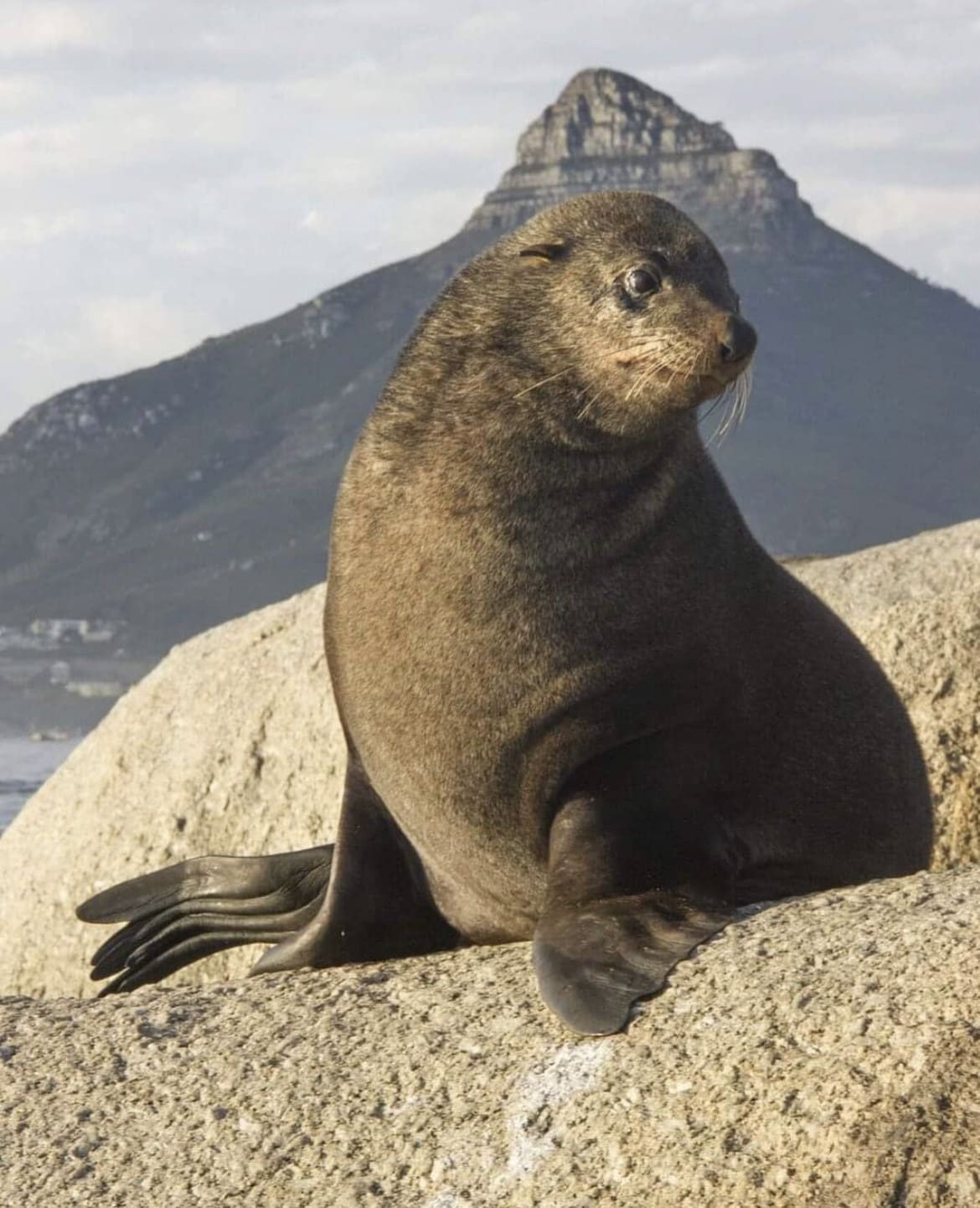
What do Cape Fur Seals look like?
Imagine the swag of a surfer mixed with the rugged charm of a wilderness explorer, and you’ve got the Cape Fur Seal. These seals are not your average marine mammal. Adult males, known as bulls, are the bodybuilders of the seal world, boasting an impressive physique that can weigh in at up to 700 pounds and stretch about 7 feet long. They’re the type to turn heads at the beach, with a thick neck and a mane that would make any lion jealous.
Females, on the other hand, are the sleek athletes of the species, lighter and more streamlined, tipping the scales at around 170 pounds and measuring up to 6 feet. It’s like comparing a heavyweight boxer to a marathon runner – both impressive, just in different weight classes.
But it’s not just size that sets these creatures apart. Cape Fur Seals have a look that’s uniquely theirs, with a pair of big, soulful eyes that seem to hold the wisdom of the ocean. Their flippers, akin to nature’s version of high-performance swim fins, give them the grace and speed that make them the acrobats of the aquatic world.
How big are Cape Fur Seals?
When it comes to size, Cape Fur Seals play in the big leagues. The males are the undisputed heavyweights, reaching lengths of up to 7 feet and sometimes tipping the scales at a whopping 700 pounds. It’s like encountering a linebacker in the middle of the ocean – imposing, impressive, and impossible to ignore.
The females, while not as hefty, still command respect with their streamlined forms, weighing up to 170 pounds and reaching lengths of about 6 feet. This size difference isn’t just for show; it plays a crucial role in their social structure and breeding strategies, but more on that later.
What’s truly fascinating is how their size contributes to their survival. The bulk of the males makes them formidable opponents for any potential threat, while the agility of the females allows them to navigate the challenges of the marine environment with finesse. Size, in the world of Cape Fur Seals, is more than just a number; it’s a survival strategy.

Cape Fur Seal Skin
Ever wondered how these seals manage to look so good, even after a deep dive? Well, the secret lies in their skin. Cape Fur Seals are equipped with a double layer of fur that would make any winter wardrobe envious. The outer layer is long and coarse, acting like a waterproof jacket that keeps them dry and toasty, even in the chilly Atlantic waters. Meanwhile, the underfur is dense and soft, providing an extra layer of insulation that’s crucial for maintaining their core body temperature.
But that’s not all – their skin is also incredibly tough, a necessary adaptation to life in a world full of sharp rocks and predatory threats. It’s like having a built-in suit of armor that’s both functional and fashionable. Plus, their skin helps them heal remarkably fast, ensuring that they’re always ready for their next oceanic adventure.
Cape Fur Seal Teeth
Now, onto the part that gives the Cape Fur Seal its bite – literally. These creatures are equipped with a set of teeth that would make any dentist pause for a moment of appreciation. Their sharp, pointy canine teeth aren’t just for show; they’re perfect for grasping slippery fish, their main diet staple. But the real MVPs in their mouths are the back teeth, or molars, designed to crush and grind their prey, making every bite count.
These dental tools are not just about nutrition; they’re also a key part of the seals’ defense system. A Cape Fur Seal’s bite is something predators and rivals would rather avoid, making it an effective deterrent against unwanted attention. In the wild, having a strong bite is akin to having a good insurance policy – it’s all about staying safe and sound.
Colouration
If the Cape Fur Seal had a Tinder profile, its colouration would definitely be mentioned in the bio. These seals sport a sleek, distinctive coat that ranges from a light, sandy brown to a darker, almost charcoal hue. The bulls tend to be darker, especially around the mane, giving them an air of rugged sophistication, while the females and younger seals boast lighter tones, blending effortlessly into the coastal landscapes.
But this stylish coat isn’t just about aesthetics; it plays a crucial role in their survival. The colouration provides excellent camouflage against the sandy beaches and rocky shores where they haul out to rest and breed, making it harder for predators to spot them. In the water, their darker backs blend with the ocean depths, while their lighter bellies match the sunlit surface, a classic case of counter-shading that tricks anyone looking for a seal snack.
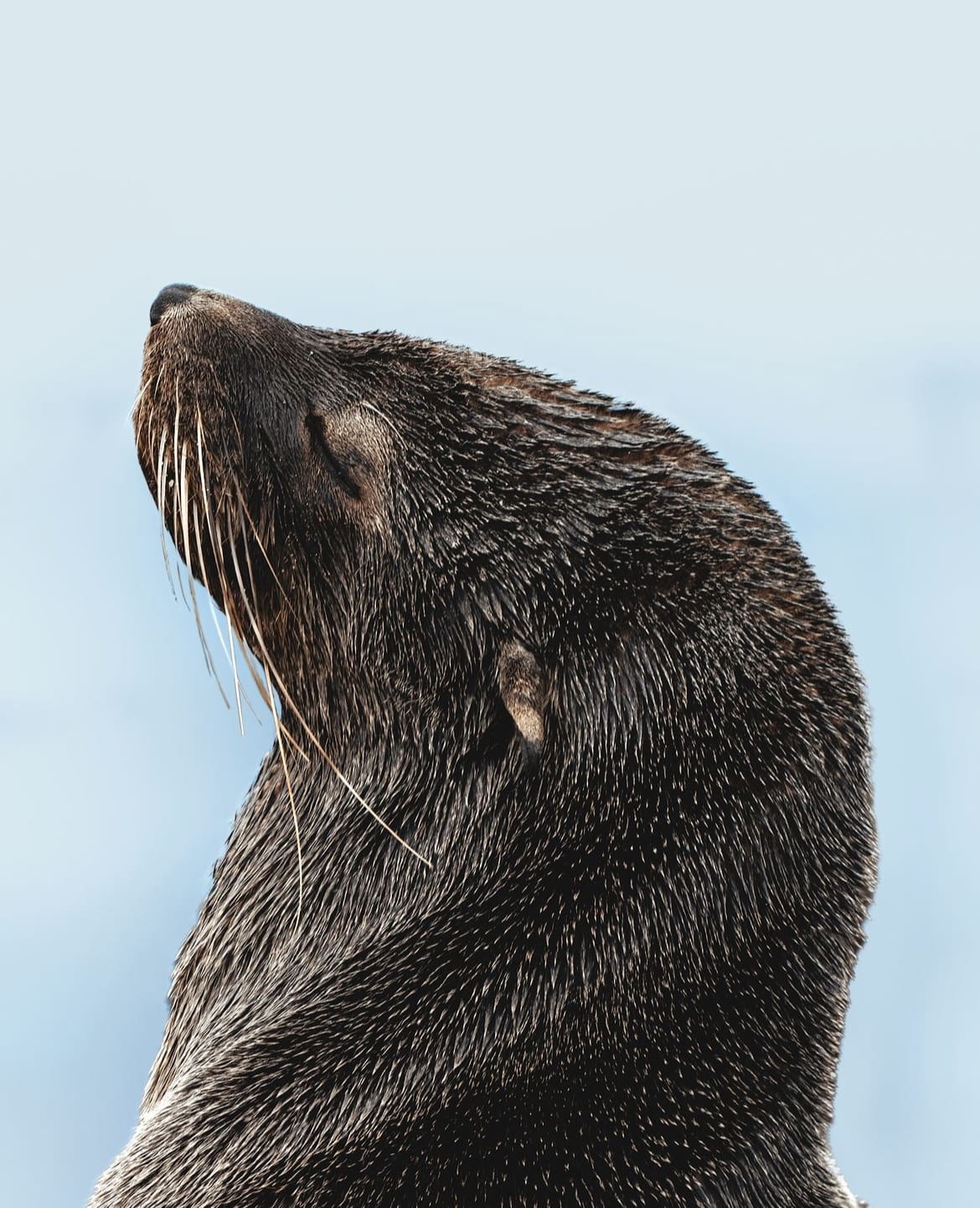
What do Cape Fur Seals eat?
Cape Fur Seals are not picky eaters, but they do have a taste for the finer things in the ocean. Their diet primarily consists of fish, squid, and occasionally crustaceans, making them piscivorous connoisseurs of the sea. Among their favorite fish are anchovies, hake, and mackerel, which are abundant in their South African and Namibian coastal habitats. These seals have a knack for finding the most nutritious and energy-rich meals, showcasing their refined palate.
Their feeding habits are a testament to their adaptability. Depending on the availability of prey, Cape Fur Seals can dive deep or hunt closer to the surface, displaying a versatility that keeps them one flipper ahead in the survival game. This varied diet not only provides them with the necessary nutrients but also plays a crucial role in the health of the marine ecosystem, highlighting their importance as apex predators.
How do Cape Fur Seals hunt?
When it comes to hunting, Cape Fur Seals could give the most skilled fishermen a run for their money. They are strategic hunters, utilizing both individual prowess and teamwork to round up their prey. During a hunt, these seals can dive up to 600 feet, holding their breath for several minutes, all the while navigating and chasing down fast-moving fish with agility and precision. It’s like watching a high-speed chase in the depths of the ocean, where agility and strategy win the meal.
At times, Cape Fur Seals will work together to herd fish into tight balls, making it easier to snatch up their dinner. This cooperative hunting strategy showcases their intelligence and social coordination, proving that in the marine world, teamwork can indeed make the dream work. Their hunting success is not just a matter of speed or strength; it’s also about the sharpness of their minds.

Cape Fur Seal Social Structure
Imagine the most happening social gathering you’ve ever seen, and you might get close to understanding the social life of a Cape Fur Seal. These animals are incredibly social creatures, forming colonies that can number in the thousands. Within these bustling communities, there’s a hierarchy and structure that would rival any corporate ladder or social club.
At the top of the social structure are the dominant males, who establish territories during the breeding season and gather harems of females. These bulls are the defenders of their domains, ensuring the safety of their mates and offspring from rivals and predators. Meanwhile, the females form close bonds with each other, raising their pups in communal nurseries where teamwork ensures the young seals’ survival.
How do Cape Fur Seals reproduce?
The reproduction cycle of Cape Fur Seals is a dramatic saga set against the backdrop of the rugged, windswept coasts of Southern Africa. Every year, during the breeding season, the beaches transform into bustling nurseries and battlegrounds for mating rights. The dominant males, having established territories, defend their harems of females with vigor and determination. It’s like the ultimate reality show, where strength, strategy, and stamina decide who gets to pass on their genes.
Females are not just passive participants in this drama; they have their own strategies for selecting mates and ensuring the survival of their offspring. After a gestation period of about 12 months, which includes a delay in implantation of the fertilized egg, females give birth to a single pup. The mother-pup bond is strong, with females nurturing and protecting their young with fierce dedication. This intensive care ensures that as many pups as possible survive the vulnerable early months of life, continuing the cycle of life for the Cape Fur Seals.
How long do Cape Fur Seals live?
In the wild, Cape Fur Seals can live a remarkably long life, given the challenges they face from predators, environmental changes, and human impacts. Females, who often play the role of both nurturer and protector, tend to live longer, with lifespans reaching up to 25 years. Males, on the other hand, live shorter lives, averaging around 15 years, partly due to the stresses and injuries from the fierce battles fought over territories and mates.
The lifespan of a Cape Fur Seal is a testament to their resilience and adaptability. Despite the harsh realities of their existence, from evading predators like sharks and orcas to navigating the impacts of climate change, these seals have managed to not only survive but thrive along the coasts of Africa. Their longevity in the wild speaks to the success of their social structures and behaviors in ensuring the continuation of their species.
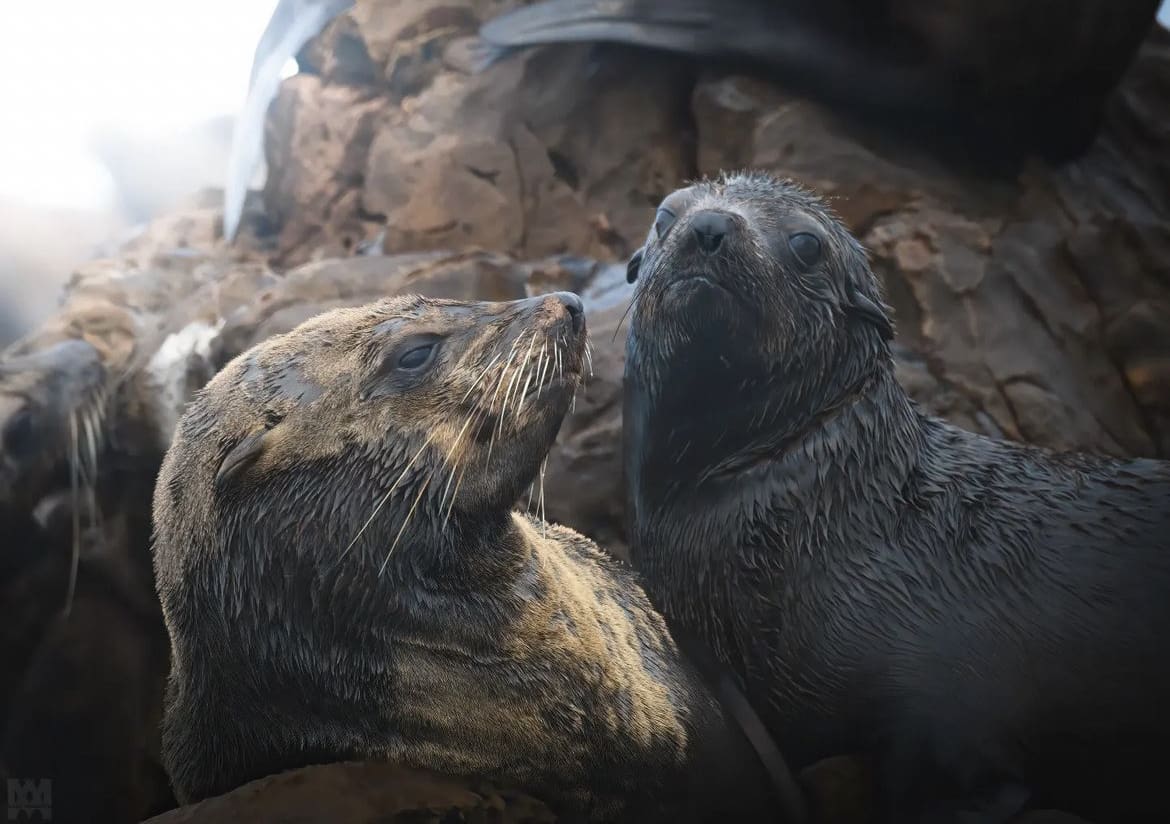
Are Cape Fur Seals aggressive?
The question of aggression in Cape Fur Seals is a nuanced one. Among themselves, males can indeed be aggressive, especially during the breeding season when territorial disputes and competition for females can lead to intense and sometimes violent confrontations. These battles, while fierce, are a natural part of their social dynamics, ensuring that only the strongest and most fit individuals reproduce.
Towards humans, however, Cape Fur Seals are generally not aggressive. Like any wild animal, they can become defensive if they feel threatened or cornered, but incidents of aggression towards people are rare. It’s important to remember that they are wild creatures, and respecting their space and observing them from a distance is crucial to avoid any negative interactions.
Are Cape Fur Seals territorial?
When it comes to real estate, Cape Fur Seals have their priorities straight. Males become highly territorial during the breeding season, staking claim to a piece of beach that they defend with gusto against any would-be rivals. This behavior ensures they have a harem of females for mating, and it’s not uncommon to see dramatic showdowns on the beaches as males go flipper to flipper over prime territory. These territories are temporary, though, and outside of the breeding season, Cape Fur Seals are much less concerned about personal space, often seen lounging en masse on the shores.
This territoriality is crucial for their social structure and reproductive success. It ensures that only the strongest and most capable males get to pass on their genes, contributing to the overall health and resilience of the population. So, while it might seem a bit aggressive from a human perspective, it’s all part of the Cape Fur Seals’ natural cycle of life.
How fast are Cape Fur Seals?
If the Cape Fur Seal were to enter the animal kingdom’s Olympics, they would certainly take home a medal in swimming. These seals are incredibly fast and agile in the water, capable of reaching speeds up to 25 kilometers per hour (about 15.5 miles per hour). This speed is not just for showing off; it’s a critical survival tool that helps them evade predators like sharks and orcas and catch their swift prey.
Their streamlined bodies, powerful flippers, and sleek fur allow them to cut through the water with minimal resistance, making them masters of high-speed chases and sudden direction changes. Watching a Cape Fur Seal hunt is like observing a ballet of speed and agility—it’s a testament to their incredible adaptations to life in a challenging marine environment.
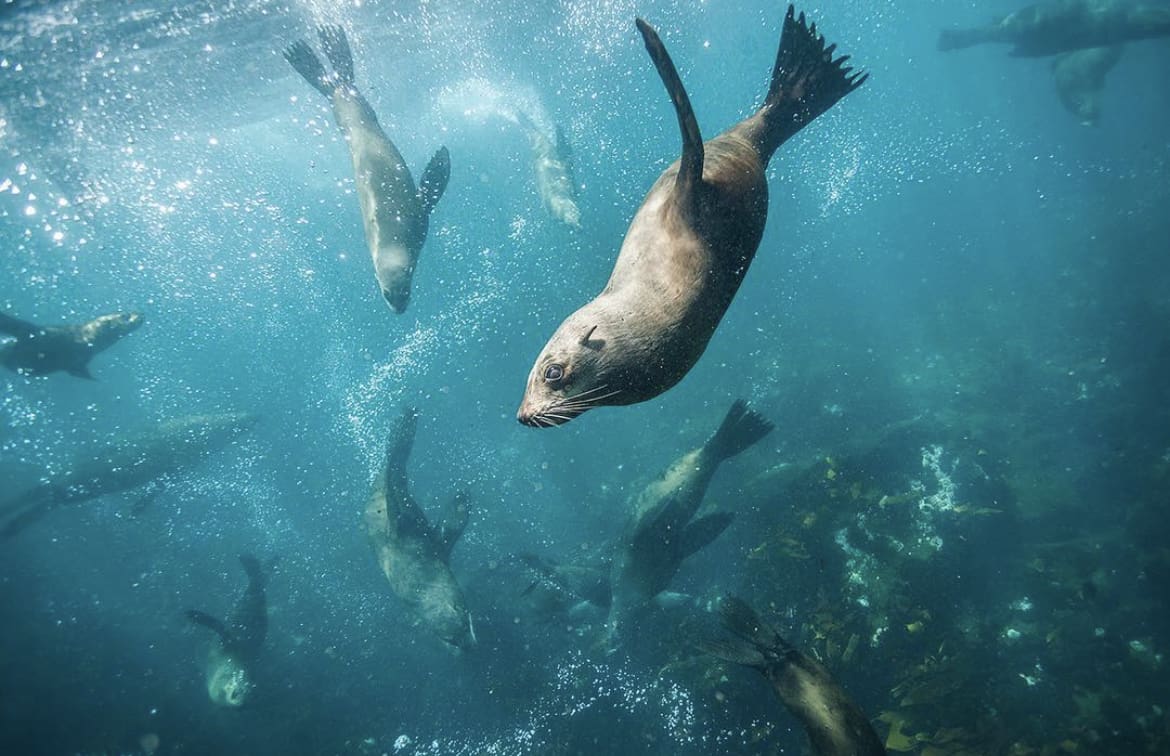
Where do Cape Fur Seals live?
Cape Fur Seals have a pretty exclusive address, primarily residing along the coasts of Namibia and South Africa. These locations offer the perfect blend of sandy beaches for breeding and rocky shores for lounging, not to mention the rich, cold currents of the Atlantic Ocean that provide a bounty of food.
Their habitat is not just a matter of preference but a crucial aspect of their survival. The cold Benguela current brings an upwelling of nutrients that support a diverse marine ecosystem, allowing Cape Fur Seals to thrive. From the Namib Desert’s skeleton coast to South Africa’s Cape of Good Hope, these seals have adapted to a range of coastal environments, showcasing their versatility and resilience.
How many Cape Fur Seals are there in the wild?
The Cape Fur Seal population is a testament to nature’s resilience, boasting numbers that run into the millions. Recent estimates suggest that there are about 1.5 to 2 million individuals sprawling across their Southern African habitat. This robust population is a significant rebound from historical lows caused by extensive hunting and exploitation in the past. Today, their numbers are largely stable, thanks to conservation efforts and a better understanding of the importance of marine biodiversity.
However, while the overall numbers might sound healthy, it’s essential to remember that Cape Fur Seals are not uniformly distributed and that some colonies are more vulnerable than others. Factors such as food availability, habitat disturbance, and climate change can affect local populations, making continuous monitoring and management vital for their long-term conservation.
Are Cape Fur Seals endangered?
Given their current population status, Cape Fur Seals are not considered endangered. They are classified as “Least Concern” by the International Union for Conservation of Nature (IUCN), indicating a relatively stable and healthy population at the global level. This classification, however, should not lead to complacency, as it masks the ongoing threats and challenges these animals face.
Conservation efforts must remain proactive to address any shifts in population trends promptly. The story of the Cape Fur Seal is one of hope and caution, showcasing the positive impacts of conservation while reminding us of the constant need for vigilance to protect these charismatic marine mammals.

Threats to Cape Fur Seals in the wild
Despite their current success story, Cape Fur Seals face a myriad of threats that could impact their populations if not adequately managed. Some of the most significant threats include:
- Overfishing: Depletion of fish stocks due to overfishing can significantly reduce the availability of prey for Cape Fur Seals, affecting their nutrition and reproductive success.
- Entanglement in Fishing Gear: Known as bycatch, entanglement in fishing nets and lines poses a significant risk, leading to injuries or death.
- Habitat Disturbance: Human activities, such as coastal development and marine tourism, can disturb breeding colonies and resting sites, potentially affecting their breeding success.
- Climate Change: Changes in ocean temperature and currents can impact the distribution and abundance of their prey, forcing seals to adapt quickly or face starvation.
- Pollution: Marine pollution, including plastic waste and chemical pollutants, can harm Cape Fur Seals through ingestion, entanglement, or habitat degradation.
Where to see Cape Fur Seals in the wild
For those yearning to witness the lively antics and social dynamics of Cape Fur Seals firsthand, there are several key locations renowned for their seal populations. The Cape Cross Seal Reserve in Namibia offers one of the largest breeding colonies, where tens of thousands of seals can be observed, especially during the breeding season. Similarly, South Africa’s Seal Island in False Bay provides a unique opportunity to see seals in large numbers, engaging in their natural behaviors.
Other notable spots include the Robberg Nature Reserve near Plettenberg Bay and the V&A Waterfront in Cape Town, where seals are often seen lounging on docks or swimming in nearby waters. Each location offers a unique viewing experience, from sprawling colonies on remote beaches to more urban encounters, highlighting the adaptability of Cape Fur Seals.
READ NEXT: WHERE TO GO CAGE DIVING WITH SHARKS NEAR CAPE TOWN
Tips for spotting Cape Fur Seals
When setting out to observe Cape Fur Seals, a few tips can enhance the experience while ensuring the safety and well-being of both the seals and viewers:
- Keep a respectful distance: To avoid disturbing the seals, always maintain a safe and respectful distance, using binoculars or zoom lenses for a closer look.
- Visit during the breeding season: For a chance to see the seals in large numbers and observe interesting behaviors like mating, giving birth, or nursing, plan your visit during the breeding season (usually November to December).
- Follow local guidelines: Adhere to any regulations or guidelines provided by wildlife authorities or tour operators to minimize impact on the seals and their habitat.
- Be patient: Wildlife viewing requires patience. Spend time quietly observing, and you’re more likely to witness fascinating behaviors.
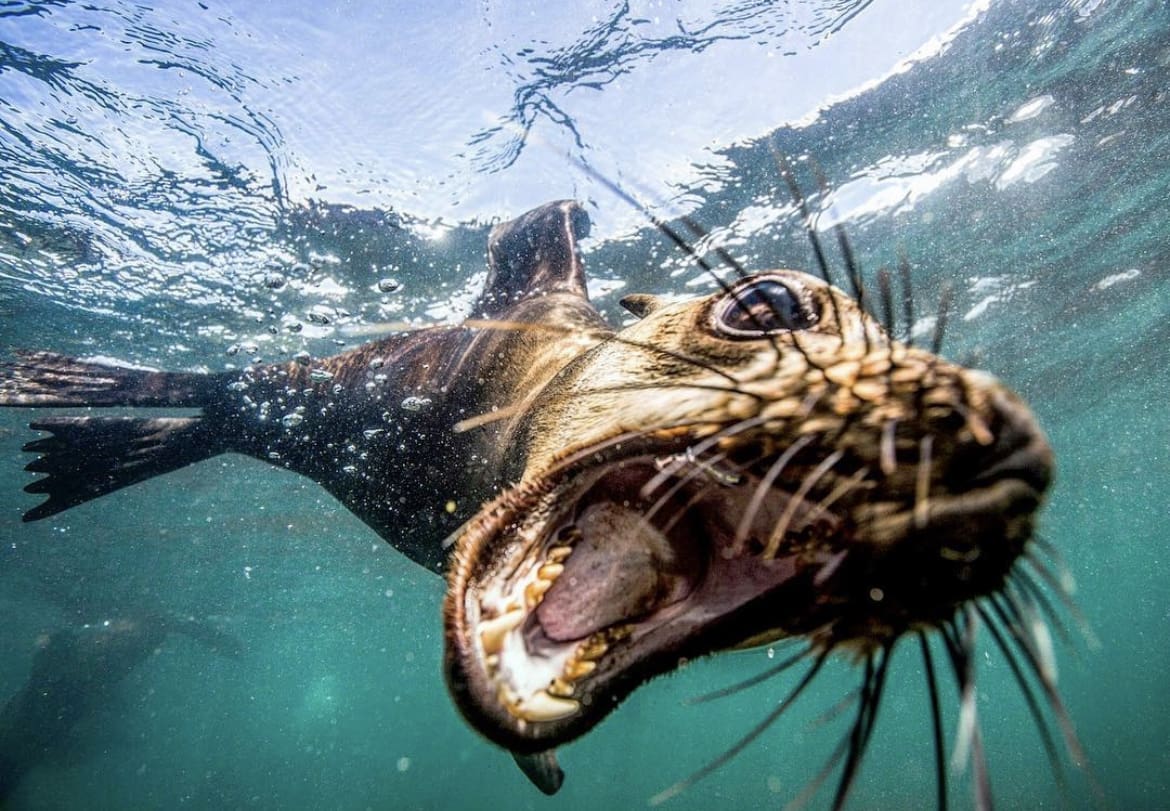
Facts about The Cape Fur Seal
To wrap up our exploration, let’s dive into some quick, fascinating facts about Cape Fur Seals that showcase their uniqueness:
- Cape Fur Seals can hold their breath for up to 7 minutes while diving.
- Their whiskers are highly sensitive, helping them detect prey in the dark depths of the ocean.
- Pups are born with a black coat, which they shed for a silver-gray fur as they grow.
- They are known to use tools, such as using their flippers to throw sand over themselves to stay cool.
Myths about The Cape Fur Seal
Dispelling myths is crucial for understanding and protecting wildlife. Here are a couple of myths about Cape Fur Seals:
- Myth: Cape Fur Seals eat excessive amounts of fish, depleting stocks for fishermen.
- Fact: Studies show that seals’ impact on fish stocks is minimal compared to human overfishing.
- Myth: Cape Fur Seals are aggressive towards humans.
- Fact: While they can be territorial during the breeding season, Cape Fur Seals are generally not aggressive towards humans unless provoked or threatened.
